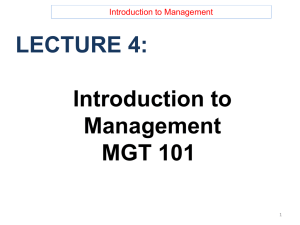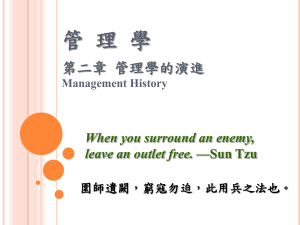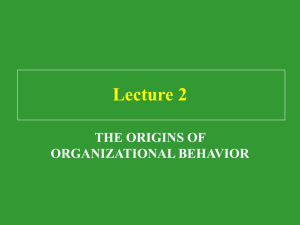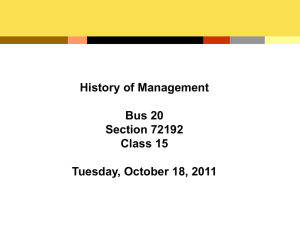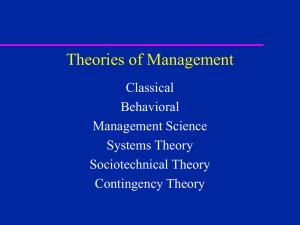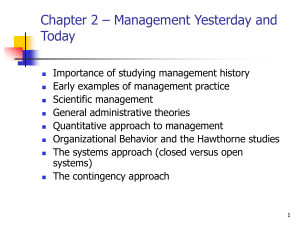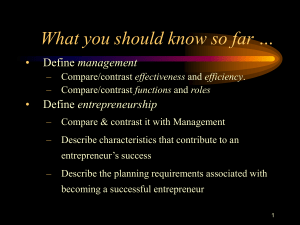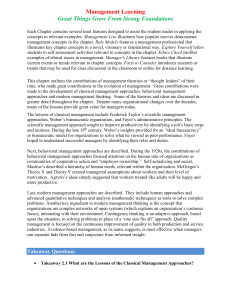Ch2
advertisement
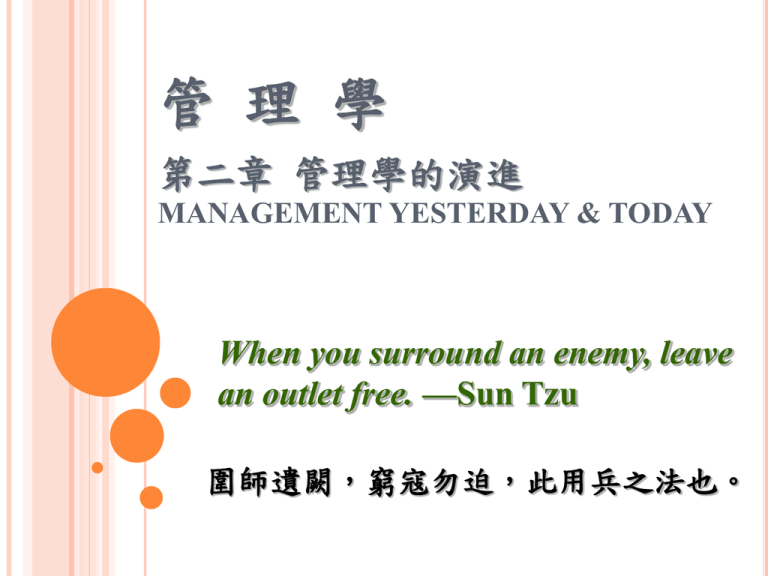
管 理 學 第二章 管理學的演進 MANAGEMENT YESTERDAY & TODAY When you surround an enemy, leave an outlet free. —Sun Tzu 圍師遺闕,窮寇勿迫,此用兵之法也。 Today is ok, 何不跳過 Yesterday, 直接研討 Tomorrow? 社會科學的發展: Economics? Psychology? Management? Marketing? 溫故知新,鑒往知來。 William James, (1842-1910)美國心理學之父, The Varieties of Religious Experience (宗教經驗之種種) , (1902) 2 綱要 1. Historical Background 2. Major Approaches to Management 3. Current Issues and Trends 3 一、HISTORICAL BACKGROUND Ancient Management Adam Smith Egypt (pyramids), China (Great Wall) Venetians (floating warship assembly lines, 會計) The Wealth of Nations (1776), division of labor Industrial Revolution Substituted machine power for human labor Created large organizations (management) 討論:學歷史,讀資治通鑑,應知今日事:解釋現在, 開拓文明視野。史前一萬年,一路玩到掛。 4 兩百年來幾次技術革命 1700, 蒸汽機,Lancashire 紡織業中心(矽谷),Watt (Bill Gates)。 1830, 鐵路,輪船。 1900, Mass Production: 鋼鐵,電力,重工程,石油, 汽車, Carnegie, Edison (GE), Rockefeller, Ford (dot.com)。 1940, 電腦 (1971, Information & Telecommunication) 討論: 上一波:石器時代4000BC, 銅3000BC, 鐵1000BC, 矽1968AD, 下一波?Biotechnology, Nanotechnology & Bioelectronics…… 5 二、MAJOR APPROACHES TO MGT 1. Scientific Management, 科學管理 2. General Administrative Theory, 一般管理理論 3. Quantitative Management, 數量方法 4. Organizational Behavior, 組織行為 5. Systems Approach, 系統途徑 6. Contingency Approach, 權變途徑 涓涓細流,匯成江河! 6 1. SCIENTIFIC MANAGEMENT Fredrick Winslow Taylor The “father” of scientific management Principles of Scientific Management (1911) Mental revolution: Using scientific methods to define the “one best way” for a job to be done. ex. 21 lb. 7 TAYLOR’S 4 PRINCIPLES OF MANAGEMENT 1. Develop a science for each element of an individual’s work, which will replace the old rule-of-thumb method. 2. Scientifically select and then train, teach, and develop the worker. 3. Heartily cooperate with the workers so as to ensure that all work is done in accordance with the principles of the science that has been developed. 4. Divide work and responsibility almost equally between management and workers. Management takes over all work for which it is better fitted than the workers. 8 Frank and Lillian Gilbreth Reduction of wasted motion Developed the microchronometer to time worker motions and optimize work performance 12生笑 (P.61) 9 THERBLIG CHART 10 HOW DO TODAY’S MANAGERS USE SM? 1. Use time and motion studies to increase productivity 2. Hire the best qualified employees 3. Design incentive systems based on output 討論: 1. Cast away, UPS VS. Federal Express, 北極特快車 2. 王董,王教授,成校長 3. SOP: McDonald, 鼎泰豐(18, 5+16g),Toyota, 高鐵清潔作業,太陽劇團,The Phantom of the Opera 11 2. GENERAL ADMINISTRATIVE THEORY Henri Fayol (p.62, 674) practice of management was distinct from other organizational functions Developed fourteen principles of management that applied to all organizational situations 12 FAYOL’S 14 PRINCIPLES OF MANAGEMENT 1. Division of work. 7. Remuneration. 2. Authority. 8. Centralization. 3. Discipline. 9. Scalar chain. 4. Unity of command. 10. Order. 5. Unity of direction. 11. Equity. 6. Subordination of individual interests to the general interest. 12. Stability of tenure of personnel. 13. Initiative. 14. Esprit de corps. 13 Max Weber Developed a theory of authority based on an ideal type of organization (bureaucracy) Emphasized rationality, predictability, impersonality, technical competence, and authoritarianism 比較: bureaucracy vs. adhocracy 14 WEBER’S IDEAL BUREAUCRACY 15 3. QUANTITATIVE APPROACH Operations Research/ Management Science to solve WWII military logistics and quality control problems improving managerial decision making by applying: Statistics, optimization models, computer simulations, DSS 16 比較: 賭場 (Black Jack, 決勝21點 ), 戰場 (二次大戰), 商場(台糖養豬,號誌連鎖,圓環殺手) 討論:LP, 限制? 17 4. ORGANIZATIONAL BEHAVIOR (OB) actions of people at work people are the most important asset of an organization Early OB Advocates: Robert Owen, Hugo Munsterberg Mary Parker Follett, Chester Barnard 18 THE HAWTHORNE STUDIES (E. MAYO) • A series of productivity experiments conducted at Western Electric, 1927~1932. • Experimental findings Productivity unexpectedly increased under imposed adverse working conditions. Social norms, group standards and attitudes more strongly influence individual output and work behavior than do monetary incentives. 19 討論: 1. Hawthorne Effect 2. Dale Carnegie 的著作 (Human Relation) 20 5. THE SYSTEMS APPROACH System Defined: A set of interrelated and interdependent parts arranged in a manner that produces a unified whole. Subsystem vs. Supra System Basic Types of Systems Closed systems: Are not influenced by and do not interact with their environment (all system input and output is internal). Open systems: Dynamically interact to their environments by taking in inputs and transforming them into outputs that are distributed into their environments. 21 Environment System Inputs Raw materials Human resources Capital Technology Information Transformation Employee’s work activities Management activities Technology and operations methods Outputs Products and services Financial results Information Human results Feedback 22 Environment IMPLICATIONS OF THE SA Coordination of the organization’s parts is essential for proper functioning of the entire organization. Decisions and actions taken in one area of the organization will have an effect in other areas of the organization. Organizations are not self-contained and, therefore, must adapt to changes in their external environment. 23 SYSTEM THINKING 補充: 1. General System Theory (K. E. Boulding), 2. Living System (J. G. Miller), 3. System Dynamics (J. W. Forrester) 4. The Limits to Growth (D. H. Meadows) 5. The 5th discipline (P. M. Senge) 24 6. THE CONTINGENCY APPROACH situational approach. There is no one universally applicable set of management principles (rules) by which to manage organizations. Organizations are individually different, face different situations (contingency variables), and require different ways of managing. 25 POPULAR CONTINGENCY VARIABLES 1. Organization size, 組織規模 2. Routineness of task technology, 技術例行性 3. Environmental uncertainty, 環境不確定性 4. Individual differences, 員工個別差異 5. 其他,如策略…… 組織理論(OT) 26 三、CURRENT TRENDS AND ISSUES 1. Globalization,全球化 2. Ethics, 倫理(職業道德) 3. Workforce Diversity,員工多樣化 4. Entrepreneurship, 創業精神 5. E-business,電子企業 6. Knowledge Management, 知識管理, Learning Organizations, 學習型組織 7.Quality Management, 品質管理 8.Other Management is an evolutional discipline. 27 1. GLOBALIZATION Management in international organizations Political and cultural challenges Working with people from different cultures Coping with anticapitalist backlash Movement of jobs to countries with low-cost labor 28 2. ETHICS Increased emphasis on ethics education in college curriculums Increased creation and use of codes of ethics by businesses 29 A PROCESS FOR ADDRESSING ETHICAL DILEMMAS Step 1: What is the ethical dilemma? Step 2: Who are the affected stakeholders? Step 3: What personal, organizational, and external factors are important to my decision? Step 4: What are possible alternatives? Step 5: Make a decision and act on it. 30 3. WORKFORCE DIVERSITY Increasing heterogeneity in the workforce More gender, minority, ethnic, and other forms of diversity in employees Aging workforce Older employees who work longer and do not retire, increased costs An increasing demand for products and services related to aging. 討論:Johnny, 關羽,包拯 31 4. ENTREPRENEURSHIP The process of starting new businesses, generally in response to opportunities. Entrepreneurship process Pursuit of opportunities Innovation in products, services, or business methods Desire for continual growth 討論:大富創業 (p.620),其次投資,受僱最穩? 32 5. ELECTRONIC BUSINESS The work preformed by an organization using electronic linkages to its key constituencies E-commerce: the sales and marketing aspect of an ebusiness 討論:Amazon.com, 無名小站 33 6. LEARNING ORGANIZATION, KM An organization that has developed the capacity to continuously learn, adapt, and change. The cultivation of a learning culture where organizational members systematically gather and share knowledge with others in order to achieve better performance. 討論:玉米田理論,Joe Girard - World's Greatest Salesperson 34 LEARNING ORGANIZATION VS. TRADITIONAL ORG. 35 7. QUALITY MANAGEMENT A philosophy of management driven by continual improvement in the quality of work processes and responding to customer needs and expectations Inspired by the total quality management (TQM) ideas of Deming and Juran Quality is not directly related to cost Poor quality results in lower productivity 討論: The devil is in the details. W. Shewhart, Edwards Deming 36 WHAT IS QUALITY MANAGEMENT? Intense focus on the customer. Concern for continual improvement. Process-focused. Improvement in the quality of everything. Accurate measurement. Empowerment of employees. 37 補充: TEAM WORK 1. Case study: a manager’s dilemma (p.57) 2. Thinking critically about ethics (p.77) 3. Internet-based exercise (p.78), 4. Team-based exercise (p.82) 38 回 顧 1. 比較:Taylor VS. Fayol 的貢獻 2. 區分: *Scientific Management VS. Management Science *Organizational Behavior (OB) VS. Organization Theory (OT) *人群關係運動 VS. 行為科學研究; *Systems VS. Contingency Approach 39 討論:經史合參學管理? 1. 君王論,戰爭論,國富論。 聖經故事,金字塔,羅馬帝國興亡史,天主教。 2. 論語,孫子,韓非子。 戰國策,楚漢、三國、隋唐演義。 (秦公司興亡史,北宋危機管理) 討論:釋道立身,儒墨處世,孫韓治事。 40 TERMS TO KNOW division of labor Industrial Revolution scientific management therbligs general administrative principles of mgt bureaucracy quantitative approach OB Hawthorne Studies system closed systems open systems contingency approach workforce diversity entrepreneurship e-business e-commerce intranet learning organization knowledge mgt quality management 41
